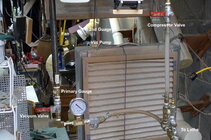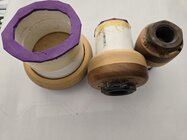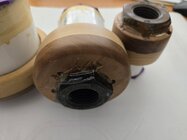-
Beware of Counterfeit Woodturning Tools (click here for details) -
Johnathan Silwones is starting a new AAW chapter, Southern Alleghenies Woodturners, in Johnstown, PA. (click here for details) -
Congratulations to William Rogers for "Ambrosia Maple Platter" being selected as Turning of the Week for September 16, 2024 (click here for details) -
Welcome new registering member. Your username must be your real First and Last name (for example: John Doe). "Screen names" and "handles" are not allowed and your registration will be deleted if you don't use your real name. Also, do not use all caps nor all lower case.
You are using an out of date browser. It may not display this or other websites correctly.
You should upgrade or use an alternative browser.
You should upgrade or use an alternative browser.
Vacuum pump problem
- Thread starter Peter D'Attomo
- Start date
Stupid first question: are you sure a relief valve isn’t open, or otherwise a crack in a hose?
Tom Gall
TOTW Team
".... went to start it, It wasn't cooperating." I assume the pump is running?
1. Check if you're getting vacuum at the spindle.
2. Do you have a ball valve for on/off operation?
3. Gauge may be bad (or plugged with dirt - highly unlikely). BTW- that is not a vacuum gauge like I've ever seen.
4. That round dial (with the orange line) below the gauge looks like it might be a needle valve. I have a similar one but in a different place in my system. Usually when in the full horizontal position the valve is closed (for full vacuum) and when in the full vertical position allows for leakage.
3 or 9 o'clock (vacuum) and 12 or 6 o'clock (open). I think this might be your problem!
1. Check if you're getting vacuum at the spindle.
2. Do you have a ball valve for on/off operation?
3. Gauge may be bad (or plugged with dirt - highly unlikely). BTW- that is not a vacuum gauge like I've ever seen.
4. That round dial (with the orange line) below the gauge looks like it might be a needle valve. I have a similar one but in a different place in my system. Usually when in the full horizontal position the valve is closed (for full vacuum) and when in the full vertical position allows for leakage.
3 or 9 o'clock (vacuum) and 12 or 6 o'clock (open). I think this might be your problem!
- Joined
- Jan 27, 2005
- Messages
- 12,991
- Likes
- 5,374
- Location
- Dalworthington Gardens, TX
- Website
- pbase.com
Could it possibly be that a loose nut on the gauge isn’t cooperating? 
That is a pressure gauge, not a vacuum gauge which explains why the needle is indicating less than zero. Also, notice that the units are pounds per square inch (PSI) and, not inches of mercury (inHg). While it’s hard to estimate the uncalibrated scale below zero since zero isn’t very well defined on the gauge, we could make a very rough guess. Twenty-seven inches of mercury is approximately thirteen pounds per square inch so I could reasonably guess that the gauge is indicating about 27 inches of mercury.
That is a pressure gauge, not a vacuum gauge which explains why the needle is indicating less than zero. Also, notice that the units are pounds per square inch (PSI) and, not inches of mercury (inHg). While it’s hard to estimate the uncalibrated scale below zero since zero isn’t very well defined on the gauge, we could make a very rough guess. Twenty-seven inches of mercury is approximately thirteen pounds per square inch so I could reasonably guess that the gauge is indicating about 27 inches of mercury.
Valve is closed. I removed the hose, only brass fittings. No leaksStupid first question: are you sure a relief valve isn’t open, or otherwise a crack in a hose?
Getting vacuum, but not much".... went to start it, It wasn't cooperating." I assume the pump is running?
1. Check if you're getting vacuum at the spindle.
2. Do you have a ball valve for on/off operation?
3. Gauge may be bad (or plugged with dirt - highly unlikely). BTW- that is not a vacuum gauge like I've ever seen.
4. That round dial (with the orange line) below the gauge looks like it might be a needle valve. I have a similar one but in a different place in my system. Usually when in the full horizontal position the valve is closed (for full vacuum) and when in the full vertical position allows for leakage.
3 or 9 o'clock (vacuum) and 12 or 6 o'clock (open). I think this might be your problem!
Ball valve is closed
Gauge is questionable, but had this when system was in use with no issues
Dial with orange line is ball valve, works ok
I rearranged and shortened the brass tubing. May have changed the line up. Will check again. Thank you all.Could it possibly be that a loose nut on the gauge isn’t cooperating?
That is a pressure gauge, not a vacuum gauge which explains why the needle is indicating less than zero. Also, notice that the units are pounds per square inch (PSI) and, not inches of mercury (inHg). While it’s hard to estimate the uncalibrated scale below zero since zero isn’t very well defined on the gauge, we could make a very rough guess. Twenty-seven inches of mercury is approximately thirteen pounds per square inch so I could reasonably guess that the gauge is indicating about 27 inches of mercury.
I agree with Bill. That is a psi gauge and not a vacuum gauge. I have never seen a vacuum gauge with a reading of more than 30.
Since you gauge doesn't have a negative range, it will not measure a vacuum.
Yes, it it's a pressure gauge, But my issue is low vacuum.
- Joined
- Feb 28, 2021
- Messages
- 1,343
- Likes
- 1,191
- Location
- Roulette, PA
- Website
- www.reallyruralwoodworks.com
Yeah I think what we are all wondering is, how do you measure vacuum with a pressure gauge? Which might be followed up by, how do you know it is low vacuum based on that pressure gauge reading? Dunno. I'm lost here. But then again if you can answer the questions well enough, maybe I learn something.Yes, it it's a pressure gauge, But my issue is low vacuum.
Not that the gauge was meant to measure below zero, it looks like it’s reading about 12-13 psi below atmospheric pressure (aka vacuum). So it’s working similar to what you described before as being good. I don’t see support for you comment about the pump not working well.
- Joined
- Jan 27, 2005
- Messages
- 12,991
- Likes
- 5,374
- Location
- Dalworthington Gardens, TX
- Website
- pbase.com
Yes, it it's a pressure gauge, But my issue is low vacuum.
How do you know that the vacuum is low? In your original post you said ...
I was previously getting 27hg, now it's not clear as the gauge shows a minus 0 measurement or more.
... which sounds to me like you were trying to measure vacuum with the pressure gauge.
Yes, 27hg equals 13.3psi. But not knowing how accurate the gauge gets when the diaphragm is being pulled backwards, who knows what it is.Not that the gauge was meant to measure below zero, it looks like it’s reading about 12-13 psi below atmospheric pressure (aka vacuum). So it’s working similar to what you described before as being good. I don’t see support for you comment about the pump not working well.
Most likely a Bourdon tube gauge; no diaphragm. As I mentioned, not meant for it, but likely acts reasonably well until it runs out of gear segment.
Tom Gall
TOTW Team
@Peter D'Attomo
"Ball valve is closed". Ball valve should be open.
"Dial with orange line is ball valve, works ok" That is not a ball valve - your hand is in the way on the photo but it sure looks like my needle valve. Used to make fine adjustments to the amount of vacuum you want when necessary. It looks like you have it in the 2:30/8:30 position which will cause a leak. Having it placed before the gauge doesn't make sense to me.
Gauges can be a little off and the reading will also vary depending on your altitude. You should just use it as a relative reference that is normal for you.
In the photo below the "Vacuum Valve" (red handle) is a ball valve. In the lower right you can see the dial of my needle (bleed) valve.
"Ball valve is closed". Ball valve should be open.
"Dial with orange line is ball valve, works ok" That is not a ball valve - your hand is in the way on the photo but it sure looks like my needle valve. Used to make fine adjustments to the amount of vacuum you want when necessary. It looks like you have it in the 2:30/8:30 position which will cause a leak. Having it placed before the gauge doesn't make sense to me.
Gauges can be a little off and the reading will also vary depending on your altitude. You should just use it as a relative reference that is normal for you.
In the photo below the "Vacuum Valve" (red handle) is a ball valve. In the lower right you can see the dial of my needle (bleed) valve.
Attachments
I would get a real liquid filled vacuum gauge. I would install it into the pump itself to measure the actual pump vacuum. This will tell you if it really is the pump or a leak or blockage somewhere else, A friend was having a similar problem and it turned out to be blockage in his line that wasn’t apparent. You say you use to get 27hg. How did you measure the 27hg. I’m guessing a vacuum gauge.
These pumps do not just suddenly have a large pressure/vacuum drop. I use the pressure side to aerate my lake and one ran 24/7 for four years. Even after that it was still pulling 15hg.
There are many different part numbers for these Thomas pumps. However all pumps are basically the same. There are rebuild kits on eBay and multiple YouTube videos on how to rebuild them. You will want a top end rebuild kit that includes the cylinders. The hardest part is getting to pump apart and getting the cylinder disc off. It is held by one screw. Likely has some thread lock and I use heat along with my impact drill to remove it. You need the right star bit to avoid stripping the screw head.
Again, first get a real vacuum gauge. I don’t think it would be the pump, but only one way to know.
These pumps do not just suddenly have a large pressure/vacuum drop. I use the pressure side to aerate my lake and one ran 24/7 for four years. Even after that it was still pulling 15hg.
There are many different part numbers for these Thomas pumps. However all pumps are basically the same. There are rebuild kits on eBay and multiple YouTube videos on how to rebuild them. You will want a top end rebuild kit that includes the cylinders. The hardest part is getting to pump apart and getting the cylinder disc off. It is held by one screw. Likely has some thread lock and I use heat along with my impact drill to remove it. You need the right star bit to avoid stripping the screw head.
Again, first get a real vacuum gauge. I don’t think it would be the pump, but only one way to know.
Last edited:
Peter, what does your guage read when the pump is off? Is it much above zero?
I replaced the gauge which fixed the vacuum, and replumbed the line. I'm now reading 15-27hg depending on chuck type. One that was purchased is registering 27, bur 3 homemade ones are at 15-19. I'm working on the homeemade chucks to improve the vacuum.
Thank you all for your help.
Thank you all for your help.
Well that sucks. (or doesn't  )
)
I'm not familiar with what type that is, but a check valve would be my first thought. If it has a diaphram, that is also a likely problem.
I'm not familiar with what type that is, but a check valve would be my first thought. If it has a diaphram, that is also a likely problem.
The home made chucks I have made I always seal the wood with shellac and put a bead of hotmelt glue around the diameter that usually helps.
Also helps a bit to make a gasket for the base end that screws to the headstock spindle.
These are the made chucks that exhibit a lower hg. The open end has new foam, and I resealed the backside epoxy around the nut.
I'm not seeing a variation within these 3, so I'm thinking the problem is with the loose threads. Has anyone added Teflon tape to the headstock, and did it help?
I'm not seeing a variation within these 3, so I'm thinking the problem is with the loose threads. Has anyone added Teflon tape to the headstock, and did it help?
I like this idea, will try it.Also helps a bit to make a gasket for the base end that screws to the headstock spindle.
Attachments
I use a rubber gasket between the chuck and spindle as stated above in addition to sealing the wood with shellac and I epoxied the pvc pipe into the wood base.These are the made chucks that exhibit a lower hg. The open end has new foam, and I resealed the backside epoxy around the nut.
I'm not seeing a variation within these 3, so I'm thinking the problem is with the loose threads. Has anyone added Teflon tape to the headstock, and did it help?
I like this idea, will try it.
@Peter D'Attomo My guess you’re leaking is most likely around the area where the plastic is epoxied into the wood. This is where I use the hot melt glue. I would also clean up the nut faces. You can also try a gasket as mentioned above. I have never needed a gasket, but my threads are tapped into the wood.


Dave Landers
Beta Tester
A friend of mine, Join Giem, has written a few articles about vacuum chucking for American Woodturner (his Oct 2014 and Feb 2011 articles are about tuning up and Improving your vacuum system). John does use teflon tape on his spindles, as at least one of his chucks does leak there.Has anyone added Teflon tape to the headstock, and did it help?
Tom Gall
TOTW Team
Many good suggestions so far.These are the made chucks that exhibit a lower hg. The open end has new foam, and I resealed the backside epoxy around the nut.
I'm not seeing a variation within these 3, so I'm thinking the problem is with the loose threads. Has anyone added Teflon tape to the headstock, and did it help?
I like this idea, will try it.
From your photos - the nuts could definitely be the problem (or part of the problem). They are stamped and look like they have some metal debris on them - they should be faced off. You can test by making a washer using some thin packing foam, or Fun Foam, over the spindle and against the flat at the back of the spindle. If that helps to pull more vacuum then you can attempt to face off the nut(s), or just add a gasket as per @Gary Beasley . For future new chucks start with truing the nut and building the chuck from there. Or, maybe use faceplates instead.
IMO, using Teflon tape would be a PITA !!! The important seal is where the "nut/insert/chuck" meets the machined flat at the back of the spindle. If your nut doesn't quite reach the flat use a machined arbor spacer.
Thanks all for the suggestion.




